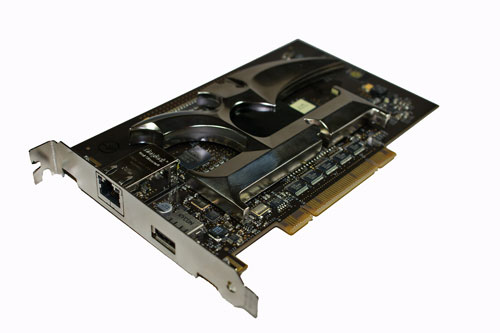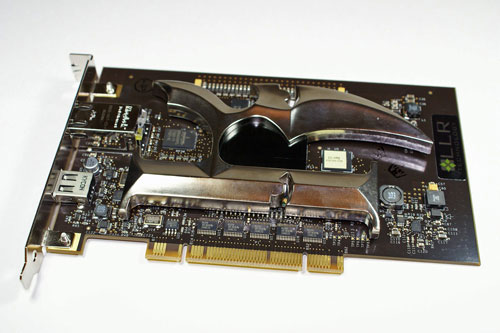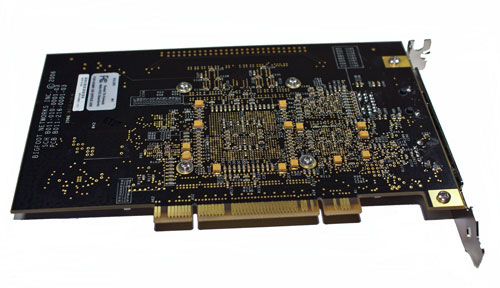BigFoot Networks Killer NIC: Killer Marketing or Killer Product?
by Gary Key on October 31, 2006 2:00 AM EST- Posted in
- Networking
Killer NIC Card
The Killer NIC ships with an installation disc that includes several Linux programs, a few decals, product documentation package, and a full retail copy of F.E.A.R. on DVD.
The Killer NIC is a very interesting card and since the Halloween season is upon us we have to say the thought of removing the "K" heatsink and using it as part of our Blade costume came to mind several different times. The PCB is black in color and contains a significant amount of components that you would never expect to see on a typical NIC. There are also several red LEDs on the PCB whose blinking movements can be adjusted by the control panel. Overall, the card's design theme follows its naming convention.
The card is equipped with a Freescale MPC8347E communications processor, a Xilinx Spartan FPGA, an integrated Broadcom Gigabit PHY, and 64MB of RAM for the embedded Linux build that is accessed by the FNapp Console. The Freescale MPC8347E communications processor is designed for general communications requirements from Ethernet routers to Internet network appliances. The Xilinx Spartan FPGA is a programmable gate array that houses Bigfoot Networks' proprietary and patent pending algorithms that also utilize the 64MB of onboard RAM.

The card utilizes a standard RJ-45 port and includes a USB 2.0 port. The USB 2.0 port is not visible to Windows and is designed to be used by an FNapp. The thought process is that an FNapp can read or write data to a flash drive or external HD. This would be very advantageous for writing data directly to an external hard drive via a BitTorrent type FNapp as one example.
The amount of integrated components along with its basic design features is one of the reasons why this card costs $279.99. This is a price tag that generally puts this card out of reach for most users who are typically satisfied with their NIC's current performance.
The card was very easy to set up. You need to disable your current NIC for optimum performance and compatibility. This is an action that we highly advise after a couple of aborted installs with the original driver set. The card requires a single PCI 2.2 slot and is only compatible with 32-bit Windows XP at this time. After installing the card, a quick reboot, and hardware recognition by XP, you install the driver set off the CD although we highly suggest downloading the latest release first. Another reboot is required and then you are set to use the card for total world domination. Well, at least this is probably your thought process if you read through the marketing material and other documentation online.
Additional 64-bit XP and Linux support is expected within the next six to eight weeks. However, it is still uncertain as to what features will be enabled for Linux and what if any performance benefits will be gained. Windows Vista support should be available by the time the OS ships and it will be interesting to see if there are any improvements considering Microsoft has completely rewritten the network stack code for efficiency and latency reduction. At this point in time there are no plans for a PCI Express version of the Killer NIC. According BigFoot Networks the PCI interface was utilized to improve transactional latencies, programming familiarity, and the fact that most systems have the required amount of PCI slots. We disagree with that last point as the majority of performance oriented boards are now PCI slot starved, and we would expect PCI-E to be a future consideration depending on the success of the current design.
The Killer NIC ships with an installation disc that includes several Linux programs, a few decals, product documentation package, and a full retail copy of F.E.A.R. on DVD.
 |
 |
| Click to enlarge |
The Killer NIC is a very interesting card and since the Halloween season is upon us we have to say the thought of removing the "K" heatsink and using it as part of our Blade costume came to mind several different times. The PCB is black in color and contains a significant amount of components that you would never expect to see on a typical NIC. There are also several red LEDs on the PCB whose blinking movements can be adjusted by the control panel. Overall, the card's design theme follows its naming convention.
The card is equipped with a Freescale MPC8347E communications processor, a Xilinx Spartan FPGA, an integrated Broadcom Gigabit PHY, and 64MB of RAM for the embedded Linux build that is accessed by the FNapp Console. The Freescale MPC8347E communications processor is designed for general communications requirements from Ethernet routers to Internet network appliances. The Xilinx Spartan FPGA is a programmable gate array that houses Bigfoot Networks' proprietary and patent pending algorithms that also utilize the 64MB of onboard RAM.

The card utilizes a standard RJ-45 port and includes a USB 2.0 port. The USB 2.0 port is not visible to Windows and is designed to be used by an FNapp. The thought process is that an FNapp can read or write data to a flash drive or external HD. This would be very advantageous for writing data directly to an external hard drive via a BitTorrent type FNapp as one example.
The amount of integrated components along with its basic design features is one of the reasons why this card costs $279.99. This is a price tag that generally puts this card out of reach for most users who are typically satisfied with their NIC's current performance.
The card was very easy to set up. You need to disable your current NIC for optimum performance and compatibility. This is an action that we highly advise after a couple of aborted installs with the original driver set. The card requires a single PCI 2.2 slot and is only compatible with 32-bit Windows XP at this time. After installing the card, a quick reboot, and hardware recognition by XP, you install the driver set off the CD although we highly suggest downloading the latest release first. Another reboot is required and then you are set to use the card for total world domination. Well, at least this is probably your thought process if you read through the marketing material and other documentation online.
Additional 64-bit XP and Linux support is expected within the next six to eight weeks. However, it is still uncertain as to what features will be enabled for Linux and what if any performance benefits will be gained. Windows Vista support should be available by the time the OS ships and it will be interesting to see if there are any improvements considering Microsoft has completely rewritten the network stack code for efficiency and latency reduction. At this point in time there are no plans for a PCI Express version of the Killer NIC. According BigFoot Networks the PCI interface was utilized to improve transactional latencies, programming familiarity, and the fact that most systems have the required amount of PCI slots. We disagree with that last point as the majority of performance oriented boards are now PCI slot starved, and we would expect PCI-E to be a future consideration depending on the success of the current design.










87 Comments
View All Comments
Gary Key - Wednesday, November 1, 2006 - link
We have been trying to develop a benchmark for BF2142 and our issues always revolve around the Titan when it is full. ;-) I tried BF2142 right before we ended testing with the Killer NIC and could not tell any difference with it. However, I did not benchmark while we were trying to develop a benchmark. If I get a chance I will go back and try it with the new drivers.soydeedo - Wednesday, November 1, 2006 - link
cool beans. thanks for that quick first impression. i was just curious if it could somehow benefit from the packet optimization etc. anywho, keep us posted should you find something noteworthy with the new drivers. =)goinginstyle - Wednesday, November 29, 2006 - link
Any update on BF2142?Nehemoth - Tuesday, October 31, 2006 - link
Now i just need that anandtech review thishttp://www.hfield.com/wifire.htm">http://www.hfield.com/wifire.htm
yyrkoon - Wednesday, November 1, 2006 - link
Looks like a flat panel, and you'd do better with a 21-23DB gain Andrew, trust me, I've had the last two years to play with both since we've been wireless internet for about that long. We have just now switched (tonight, just got he hardware) to AT&T 'Wi-Max', and it is much much better than our previous provider using 802.11/G. Get this, it doesnt even need a dirrectional, just set it next to a window (such is true in our case), and you're getting an instant 2.52Mbit from a tower 8 miles away.It's pretty dahmed cool, and I didnt believe it myself, until I hooked up a neibors system for him, and he's got it in a window that sits on the opposite side of his house from the tower. Although, from the little technical information the tech support team was able to provide me with, it's only availible in our town, and only if you cant get DSL, supposedly, this is some sort of trial service for them, to determine whether its feasable to setup in other areas *shrug*. Nothing like downloading at 200 KB/s +, seen it swing as high as 800+ KB/s
feelingshorter - Tuesday, October 31, 2006 - link
Buddy, that thing is realistic. Dont tell me you never herd of a directional antenna?!?!? Thats all it is. No its not overpriced because good antennas cost a lot and it does stop your internet from dropping.Frumious1 - Tuesday, October 31, 2006 - link
Only problem is it's completely impractical for laptops where you move around a lot. For desktops, if you want a consistent quality connection, just run the damn wire and be done with it. The fastest wireless 802.11 stuff can't even come close to 100 Mbit for typical use, let alone gigabit!yyrkoon - Tuesday, October 31, 2006 - link
I have to admit, I'm a bit disappointed in you fellas, for not even benching the in-expensive Intel PCI-E NIC http://www.tigerdirect.com/applications/searchtool...">Intel Pro 1000 PCI-E, Or atleast comparring the two. For $40 USD, this card should perform very close, if not better than the $300usd 'snake oil' NIC.
*sigh*
Gary Key - Tuesday, October 31, 2006 - link
We tested the Intel PRO/1000 PT and the Koutech PEN120 PCI-Express Gigabit adapters. Both adapters scored slightly less than the NIVIDIA NIC across the board in our tests so we did not show the results. Both cards support Linux so that is a plus but then again we were reviewing a NIC designed for Windows based gaming.yyrkoon - Wednesday, November 1, 2006 - link
Hmm, guess i missed that review, however, the last review on saw on the Intel PCI, and Onboard Intel solutions (a year or so ago from *ahem* THW, showed both those leading the pack, of course, I guess the killer NIC wasnt availible at that time . . .